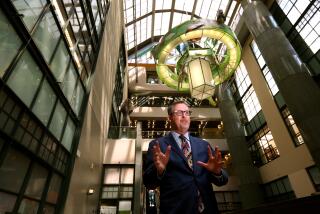Boston Athenaeum Is a ‘Bibliophile’s Dream’
- Share via
BOSTON — Down the street from the gold-domed Massachusetts State House and Boston Common at 10 1/2 Beacon St. is the Boston Athenaeum, one of the oldest and most distinguished independent libraries in America.
Founded in 1807, this was the library of Ralph Waldo Emerson, Daniel Webster, Henry Wadsworth Longfellow, Amy Lowell and Oliver Wendell Holmes.
Today the Boston Athenaeum is the library of 1,049 shareholders, 500 life members and 3,600 regular card holders. Half live in the Boston area, the rest are scattered worldwide, including several in Los Angeles and California.
Housed in the five-story sanctum are 700,000 volumes including the personal libraries of George Washington and John Quincy Adams, a collection of books presented to the Colonies by the King of England in 1698, books from the libraries of Thomas Jefferson and Benjamin Franklin, and more than 100,000 rare books, many dating to the 16th Century.
“The Boston Athenaeum is a bibliophile’s dream, a Victorian place where monastic silence prevails, a marvelous corner of the world,” said Roberta Sheehan, 35, who wrote her doctoral dissertation in philosophy here, then joined the 45-member staff at the first opportunity.
Literary Society Launched
With its publishing house, one of the city’s outstanding art and sculpture galleries and a host of cultural programs, the Athenaeum is more than a library, Sheehan added.
Its origin can be traced to 14 Harvard men who banded together to launch a literary society that in turn gave birth to the Boston Athenaeum. (An athenaeum is an institution or society for promotion of learning. In classical times the Greek Athenaion was a temple dedicated to the goddess Athena where poets came to read their works aloud.)
“Inspired by the Liverpool Athenaeum, the founders decided Boston, the Athens of the Colonies, needed not only a library of its own but a literary magazine, an art gallery, a studio for visiting artists, a laboratory for visiting scientists and a meeting place for learned people. It was all of that in the beginning,” explained Rodney Armstrong, 65, director-librarian since 1973.
By 1850, it had become one of the three largest libraries in the United States, along with the New York Library and the Library of Congress. It was also the first library in America to have a woman on its staff.
“I feel like a child in a candy shop every time I come to the Athenaeum,” said Nancy Hilton, 61, an authority on 19th-Century British literature.
Dues are $100 a year, $150 for family memberships. Even shareholders pay $100 annual dues.
The number of shareholders remains constant. Until the 1960s, shares in the Boston Athenaeum were traded over the Boston Stock Exchange.
“There are more than 200 on a waiting list to buy a share. Many of Boston’s leading families have been shareholders for more than a century. Seldom is a share sold. It is generally inherited when a shareholder dies,” Armstrong said.
Quality of Service
Many members, even those living close by, phone in requests for books. Those living outside the city call or write for books to be sent. The library prides itself on quality of service to patrons. Books are in the mail the day the order is received.
Members who visit the library are greeted by name. They go directly to the shelves and have access to all resources, including the 16th-, 17th-, 18th- and 19th-Century rare books.
The library spends a large portion of its annual budget on new acquisitions and many members have willed their personal libraries and art works to the Athenaeum.
Confederacy Collection
It has outstanding collections in many fields. During the chaotic times after the Civil War, for example, staff members traveled throughout the South collecting Confederate newspapers, government and military documents, sheet music and other materials. Today the library has one of the strongest Confederacy collections in existence.
Also unique is a remarkable collection of Gypsy books, manuscripts and documents that were donated to the library. It has since been expanded and is now considered the finest assemblage of Gypsy material in the country.
More to Read
Sign up for our Book Club newsletter
Get the latest news, events and more from the Los Angeles Times Book Club, and help us get L.A. reading and talking.
You may occasionally receive promotional content from the Los Angeles Times.








